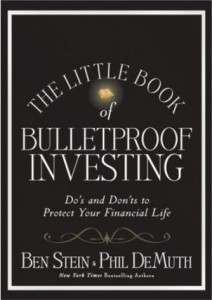“A wealth of common sense” – John C. Bogle
“A concise, comprehensive financial guide that goes down like chocolate mousse.” – William Bernstein
“Buy this one.” – Cliff Asness

Quotations
If you didn’t lose a lot of money during the Panic of 2008, you were probably doing something wrong.
The brain is like a Tootsie-Roll Pop. The brain stem is the white stick. It is surrounded by a chewy chocolate center, the limbic system, where fear and rage and emotions lurk like a bag of snakes. Finally, it is covered by the cortex, the hard candy shell where thinking occurs. Most of our decisions are emotional at base, and the cortex just makes up reasons to justify them after the fact. The brain wanders through our modern world of fax machines and skyscrapers ever on the lookout for flesh-tearing saurians.
Unconsciously we buy stocks that are a reflection of our ego ideal. Instead of a diligent analysis of the P&L statement, we buy companies that we think are cool, like we wish we were. We build a portfolio of nifty companies, in the hope that some of their heat will flow to us via the laws of thermodynamics or by contagious magic.
If you get lucky with a stock, wait a year or two before you decide to sponsor an America’s Cup team.
Wall Street uses its money, power and prestige to capture your assets (by flattery or intimidation), etherize you on the table, and pick your pockets. The focus is always kept on the markets, never on the man behind the curtain. Investment Advisor William Bernstein has calculated that, if we have a full-service wrap account at a name-brand brokerage firm, in 23 years they will have more of our money than we do. These Beagle Boys don’t break in and clean out our money bin all at once. They do it one drip at a time, keeping the patient alive (if comatose) as long as possible. Meanwhile, they hide in steel and glass office buildings behind mahogany desks and Bloomberg screens, fire off impossible-to-interpret statements, and print quarterly newsletters full of stock market doubletalk to make sure we feel ignorant and confused and, above all, in need of their ongoing help.
Strange to say, we know a great deal about what not to do when it comes to investing, but only a few positive things about what to do. However, these few things are extremely powerful.
– Simplify
– Diversify
– Invest passively
– Minimize expenses and taxes
– Buy and hold
At some point you will hear the idea that the world has changed and this time it’s different: there is some New Order, New Paradigm, New Normal, New Economy. This is bunk. There is no new anything. There are just the same old financial products, repackaged.
When people say they have a high risk tolerance, what they really mean is that they are willing to make a lot of money. Once the market goes down, their risk tolerance shrinks like an Italian suit in the washing machine.
If you are a “high net worth” type, you need to be especially careful. The industry hunts these fatted calves to extinction, using subtle appeals to status and snobbery. Most would be vastly better served bypassing the private banking department and investing in a few index funds alongside Joe Sixpack.
On the coming of retirement: right now, you are on a luxurious private jet that is flying you in great style to an airport in a remote third-world country where you will be picked up by a broken-down bus, driven to the mountains, and never heard from again.
Why are seniors always portrayed walking on the beach? Is this a polite way of reminding them that they are on the cusp of eternity?
Ultimately, there is no such thing as a safe withdrawal rate. The safe withdrawal rate is zero.